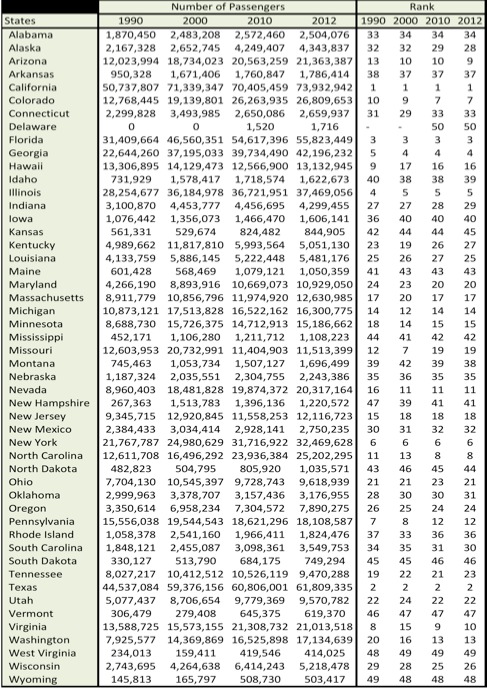By Caroline Carpenter and Mary McCleary
There are several indicators we frequently use to measure the health of Ohio’s economy – namely job growth, labor force participation, and employment. However, other factors also give us a glimpse into how Ohio is performing relative to other states. One such indicator is airport passenger data, specifically how many people are traveling out of the state by plane. Unfortunately, though not surprisingly, Ohio is a laggard relative to other states in the amount that its citizens travel by air – whether for business or for pleasure.
Though Ohio is the seventh largest state in terms of population, Ohio only ranked 21st among the states for air travel in 2012. Ohio has maintained fairly consistent in the rankings from 1990 to 2012. However, in spite of rankings, Ohio had over 926,000 fewer passengers in 2012 than it did in 2000, a drop of 8.8 percent. In terms of raw numbers, only Missouri, Kentucky, Pennsylvania, Michigan, Hawaii, and Tennessee lost more passengers during this time. Overall from 2000 to 2012, the number of passengers in the United States increased by almost 45 million, a 7.5 percent jump.[1]
While Ohio did add about 2 million passengers from 1990 to 2012, the state’s growth rate ranked 9th worst in the country. Similarly, from 2000 to 2012, Ohio’s growth (or lack thereof) in air traffic was 8th worst. However, from 2010 to 2012, Ohio improved to 32nd best.[2]
In 2012, Cleveland was Ohio’s busiest airport and ranked 41st among all airports in the country. Columbus was ranked 51st, and Cincinnati was ranked 52st. Interestingly, in 2000, Cincinnati’s air traffic was 20th highest in the United States, while Cleveland and Columbus ranked 34th and 52nd, respectively.[3]
From 2000 to 2012, with the exception of Tennessee, the ten states that experienced the largest decline in passengers were all forced unionization states. Meanwhile, in raw numbers, six of the ten states that added the most passengers have right-to-work laws – the four exceptions being New York, California, Washington, and Colorado. The Atlanta airport, located in right-to-work Georgia, has had the largest amount of passenger traffic since 1995, when it surpassed Chicago O’Hare.[4]
It is not a coincidence that airport passenger traffic is increasing in states and cities that are economically doing well. Atlanta is booming. In North Dakota, the number of passengers increased 105 percent between 2000 and 2012. During this time period, in North Dakota, the number of private sector jobs grew 41 percent – the highest in the country.[5]
On the other hand, some states and cities do well economically because they build the infrastructure to keep up with growing demands and to entice businesses that need access to major airports. For example, near the end of 2011, Chiquita Brands International, Inc., the giant banana producer, announced that it would move its headquarters from Cincinnati to Charlotte, North Carolina. The company’s main reason for making the decision was the fact that the Charlotte airport has many non-stop flights both domestically and internationally, unlike Cincinnati.[6] NCR stated the same reason related to the Dayton Airport for its move to Atlanta.
The decline of the Cincinnati airport was detrimental to Chiquita’s business since the company relies heavily upon the airport for travel to Europe and South America. In 2005, Cincinnati had over 600 daily departures with 130 destinations. With the reduction in flights by Delta Airlines, the impact on businesses was significant. When Chiquita announced its move near the end of 2011, the Cincinnati airport only had 191 departures to 52 cities.[7]
Good airports with plenty of daily departures and non-stop flights are essential to attracting and retaining big businesses. Time is money, and layovers increase the cost of travel for companies. Layovers also increase the chances of flight delays, which seem all too common.
Unfortunately for Ohioans and Ohio-based companies, the state’s major airports are not improving and do not have plans to significantly expand. Even if demand for expansion existed, there is no good way to accommodate it in Columbus. As Matt Mayer details in his book Taxpayers Don’t Stand a Chance: Why Battleground Ohio Loses No Matter Who Wins (And What To Do About It), the Columbus airport has no room to grow because it is surrounded by buildings and highways. [8]
Declines in air traffic and jobs in Ohio are symptoms of greater systemic problems. Until the big issues, such as worker freedom, regulatory reform, and government spending, are addressed, Ohio will not be an engine for job creation relative to other states, and businesses will not flock here. Unfortunately, as the economy flounders, flight options decrease, which only further seals Ohio’s fate as a laggard.
Caroline Carpenter is a senior at Worthington Christian High School. She conducted the research for this project as an O2 intern during the summer.
[1] Research and Innovative Technology Administration Bureau of Transportation Statistics, “All Carriers: T-100 Domestic Market (All Carriers),” at http://www.transtats.bts.gov/DL_ SelectFields.asp?Table_ID=310 (November 24, 2013).
[2] Ibid.
[3] Ibid.
[4] Ibid.
[5] Bureau of Labor Statistics, “Economy at a Glance” at http://www.bls.gov/eag/ (November 24, 2013.
[6] The Cincinnati Enquirer, “Chiquita CEO thanks Cincinnati on way out,” November 29, 2011, at http://news.cincinnati.com/viewart/20111129/BIZ01/311290018/Chiquita-CEO-thanks-Cincinnati-way-out (November 24, 2013).
[7] Ibid.
[8] Matt A. Mayer, “Taxpayers Don’t Stand a Chance,” page 64, July 2012, Provisum Strategies LLC. For more information about the book, visit https://www.opportunityohio.org/book-2/.


